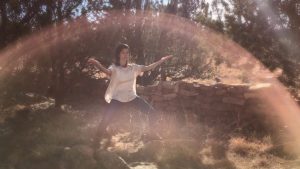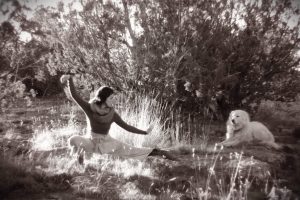Brea Fisher – interview with a Tai Chi woman
I am passionate about Taijiquan and Qi Gong. And I am a woman. And I think that women are a bit underrepresented in the Tai Chi and Qi Gong world. I mean, look at all the big masters, they are mainly men! So I want to raise the awareness for all the wonderful women in our community. Thus I often interview Tai Chi and Qi Gong women. In this interview I talk to Brea Fisher whom I first “met” on Instagram. I love the videos she is posting there!
Brea Fisher, please tell us a bit about yourself:

My name is Brea, pronounced “bree” and I am an artist. I consider art to expand the boundaries of what is typically considered to be so. Although I went to school for photography and still identify with the photographic arts as part of my own, I equally give my qigong, taiji, and gongfu to my art, which I practice and teach in the US.
In the sense that the word gongfu translates to focused practice given forth over time, to cultivate excellence in one’s art, my art at once encompasses and transcends the visual, performance, conceptual, and experiential. My art is caring for my hens and ducks; it is a long walk through the arroyo (creek bed) behind our home after a monsoon rain; it is hauling our drinking water down the long, boulder-dotted pathway by the 5-gallon jug; it is my meditation practice; or the act of making a meal for my beloved; or a small poem whispered to the leaves of an Aspen tree in autumn; and my art is largely the documentation, exploration, and sharing of my Chinese internal and martial arts practice through writing, photography, and film.
Please share some details of your Taijiquan/Qi Gong journey?
I began studying the Chinese internal and martial arts in 2007, with the initial emphasis on gongfu. My first sifu was Master Sing Chui, whose lineage connects back to Yue Fei (1103-1142 bc), the creator of the 108 Hands style that evolved into Eagle Claw Turning Style (Ying Zhao Fan Zi Men). With Master Chui’s blessing, I began teaching my own classes in 2011.
I knew I wanted to learn taiji quan from the moment I first saw it demonstrated, and not long afterward I was fully committed to the training. When my sifu moved out of state in 2013 I soon after followed on my own path to find my next home. In the first year of living in New Mexico, I trained for hours every day on my own, deeply listening to my inner teacher.
I have had several beautiful teachers in between 2007 and now, but until I met Master Zhenzan Dao at the very start of 2017, I had only known Master Chui as one I would call my sifu. I am currently enrolled in the extraordinary and thorough sifu training program at the MogaDao Institute, under the direct guidance of MogaDao founder, Master Zhenzan Dao. I am studying all the MogaDao disciplines: qigong, gongfu, meditation, yoga, and sexual health and vitality with the ultimate goal of certification to teach all of the incredibly potent MogaDao forms.
Finish this sentence: When I started learning Taijiquan and/or Qi Gong, I would have liked to know…
It would have been incredibly helpful to have known certain things from the very beginning of my journey as a taiji and qigong practitioner. I would have liked to know how valuable daily practice is to my overall wellbeing. And to have known that a short amount of consistent, regular practice is much more beneficial than a long amount of inconsistent practice once in a while.
I began my training thinking that the classes I took would be enough to get me to the place I wanted to be for my personal practice goals, and it took me time to realize that without bringing the practice home and making it a regular, if not daily, ritual, the movements and meditations were not going to become a part of me in the most potent ways I was seeking. In other words, even just a ten-minute practice every single day will bring you more benefit than an hour-long practice once a week. You’ve got to bring it home, practice by and with yourself, and do it regularly, to really begin to see the powerful effects of qigong and taiji quan.
I totally agree, continous practice is so important to reap all the benefits of the wonderful arts!
Is there anything that you specifically learnt from your first teacher that you still remember? A lesson or insight that you keep dear to your heart?
My sifu, Master Sing Chui, used to say, “See everything.” He called it the Eagle Vision– (remember our style is Eagle Claw). The idea is one that helps me in many situations both in and outside of practice. You use the whole of your eyesight– you watch the entire scene that reaches to the furthest limits of your peripheral view, by keeping the focus spread out as opposed to focused on one point.
For instance, say you are working with a partner in two-person gongfu practice. If they slowly send you a fist, you don’t need to know beforehand whether it will come as a hook to the temple or a spear palm to the throat, your eyes are placed on their chest, seeing with the Eagle Vision, and when they begin the movement you will see it as a part of the whole scene and be able to calmly respond. Compare that to staring at their right fist in anticipation of a punch toward you; if they decide to give you a kick to your kidney instead, you would be less quick to respond and that unpreparedness would likely make you react with tension.
You can apply this idea to life and daily interactions, such as navigating crowded spaces or congested traffic, as well as a tool to stay calm about where you’re at in life in general– it’s a metaphor for keeping a broader perspective and seeing your life from the aerial view as opposed to looking at it from the limited point of view of this specific moment in time.
Oh, I like the idea of aerial view. That really helps me in my everyday life. To step back and then focus on what is really important in my life.
What are you currently practicing? Do you have any personal goals in Taijiquan and/or Qi Gong?
For the last 10 months I’ve been deeply immersed in the MogaDao Institute disciplines. I’m part of the sifu training program which is rigorous as it is, and my years of prior qigong, taiji, and gongfu training have helped me tremendously. The part of the MogaDao training that I am most excited about is seeing how the MogaDao yoga practice is informing my Chinese martial and internal arts practice. The two go hand-in-hand and I can’t believe I went so many years without it. If you are a yoga practitioner, qigong is a perfect compliment and if you practice the martial and/ or internal arts, you need yoga to help you meet your best potential in your practice.
How does your Taijiquan and/or Qi Gong practice impact your everyday life?
Oh this question is great. Qigong and taiji touch on every aspect of my daily life. When you practice qigong and taiji you begin to access the wisdom of the body, and what the body knows has such profound impact on your life — your life– that you can’t help but notice it.

For me, the first thing I really began noticing in the early phases of my practice was the ability to remain calm in situations that would typically have caused me to react or get hung up in the mind. By regularly slowing your movements through your practice, you create a foundation of mindfulness — when the body slows its movements, the breath follows, and then the mind falls into line after that.
Slow the body, lengthen the breath, calm the mind.
Once you begin to make this sequence automatic, you can use it in stressful or high-tension situations. You can either physically slow down your movements to inspire the calm, or, you can get to the place where you can tap into a qigong state of mind because you’re so accustomed to going there from your regular practice that going there in the mind works just as well.
The Qi Gong state of mind is a powerpul place to be in! I consider it a true gift to know it.
I think that it is best to learn from a teacher in person, but which book taught you the most? Which would you recommend to a friend?
I agree with you about learning in person, and would add an extra recommendation to steer away from seeking qigong or taiji from a book without first having had practice and instruction with a teacher. However, there are some beautiful books out there on the practice and for those already studying. I would recommend Kenneth Cohen’s The Way of Qigong: The Art and Science of Chinese Energy Healing*. Ken Cohen has a way of presenting incredibly potent teachings in a humble way that is accessible to many. He uses everyday language and offers qigong forms and meditations that I practice and to which I refer regularly.
Now if you, dear reader, would like to know more about Brea Fisher go to her homepage “Kwan Yin Kung Fu & Tai Chi” or have a look at her wonderful Instagram account.
Happy Qi!
Angelika
